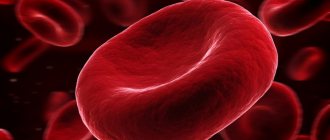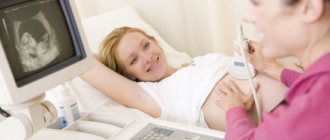GESTOSIS IN PREGNANT WOMEN: Issues of diagnosis and obstetric tactics
Is gestosis in pregnant women an independent disease?
What determines the course of gestosis?
What degrees of nephropathy are usually distinguished?
What pathogenetic therapy is prescribed for gestosis in pregnant women?
Preeclampsia in pregnant women is a syndrome of multiple organ functional failure that develops as a result of pregnancy or is aggravated in connection with pregnancy. Its main symptoms are: pathological weight gain, edema, arterial hypertension, proteinuria, seizures and/or coma. Gestosis in pregnant women is not an independent disease, it is a syndrome caused by a mismatch in the capabilities of the adaptive systems of the mother’s body to adequately meet the needs of the developing fetus. This discrepancy is realized through varying degrees of severity of perfusion-diffusion insufficiency of the placenta.
Isolating hypertension and proteinuria separately in the group of gestosis, most foreign authors, with a combination of symptoms (edema, proteinuria, hypertension), regardless of their severity, define this condition as preeclampsia. This emphasizes the difficulty of determining the severity of gestosis.
Our country has adopted a classification that includes four clinical forms of gestosis: dropsy, nephropathy, preeclampsia and eclampsia. Some authors recognize the existence of another monosymptomatic clinical form - hypertension in pregnant women, and also divide late gestosis into “pure” and “combined”, that is, developing against the background of chronic diseases that existed before pregnancy.
The prevalence of gestosis remains high (about 12-27%) and does not tend to decrease. Its course largely depends on previous diseases, and therefore uncomplicated and combined (complicated) forms of gestosis are distinguished.
Preeclampsia due to kidney disease is difficult and has adverse consequences for the fetus and newborn. In recent years, there has been an increase in the number of cases of renal pathology in pregnant women. Thus, gestational pyelonephritis is detected in 6-8% of pregnant women, glomerulonephritis - in 0.1-0.2%.
Preeclampsia due to kidney disease develops from 18-22 weeks of pregnancy. The early onset of gestosis should always be alarming - we may be talking about a combined form of the disease. The presence of this diagnosis should be clarified, since the treatment of combined forms has its own, very significant features. Pregnant women with kidney disease and gestosis, especially with severe hypertension, often (5-6%) experience premature abruption of the normally located placenta with serious consequences for the health of the mother and fetus.
As a rule, gestosis is severe due to hypertension. Even neurocirculatory dystonia of the hypertensive type in combination with gestosis in some women determines the severe course of the disease.
Preeclampsia apparently develops as a result of an imbalance between maternal antibodies and the antigenic structure of the fetus. During pregnancy complicated by gestosis, the production of antibodies and the number of circulating immune complexes increase. The deposition of these complexes on the surface of the endothelium causes platelet aggregation, tissue damage, and fibrin deposition. In addition to the direct damaging effect of antibodies, they reduce the synthesis of prostacyclin and thereby disrupt the ability of the vascular wall to prevent vascular spasm, platelet aggregation and intravascular thrombosis. The decrease in prostacyclin occurs in parallel with damage to endothelial cells. Immune vasculitis occurs with choriodecidual damage, release of tissue thromboplastin, fibrin, fibrinogen. Damage to the endothelium causes a number of negative consequences, which are most clearly manifested in the form of hypertension, proteinuria and edema. Damage to the endothelium is quite common, which makes it possible to classify severe gestosis as a group of endothelial diseases and justify the inevitability of the development of multiple organ failure in this pathology of pregnancy.
The ability of endothelial cells to produce prostacyclin decreases with hypertension, diabetes mellitus, and obesity, so gestosis occurs more quickly against the background of concomitant extragenital pathology and is always accompanied by severe multiple organ failure. In pregnant women with pyelonephritis, the level of endotoxin in the blood increases with a simultaneous decrease in antiendotoxin antibodies. Against the background of immune vasculitis, the production of prostacyclin decreases and the amount of thromboxane increases, which, with an increase in pulmonary and peripheral vascular resistance, leads to an increase in arteriolar tone, cerebral vasospasm, platelet aggregation and disseminated intravascular coagulation syndrome.
An important point is determining the severity of gestosis. There is no doubt that the combined form of gestosis can be considered the most severe. Early onset of gestosis and its presence for more than three weeks should be taken into account as unfavorable prognostic signs.
It is customary to distinguish between grade III nephropathy. In grade I, swelling of the legs occurs, blood pressure is increased by 25-30% (about 150/90 mm Hg), and moderate proteinuria is noted (up to 1.0 g/l). In stage II of the disease, pronounced swelling of the legs and abdominal wall is detected, blood pressure increases by 40% compared to the initial level (170/100 mm Hg), proteinuria is more pronounced (from 1.0 to 3.0 g/l) . Stage III is characterized by pronounced swelling of the legs, abdominal wall, face, an increase in blood pressure relative to its initial level by more than 40% (above 170/100 mm Hg) and severe proteinuria with protein content in the urine (more than 3 .0 g/l). This division does not always justify itself in practice, since even with grade II nephropathy (and sometimes grade I), severe complications and development into preeclampsia and eclampsia are possible. Therefore, many obstetricians distinguish between mild and severe forms of nephropathy. Severe nephropathy may be considered preeclampsia; In this case, patients need intensive therapy, and if its effectiveness is insufficient, immediate delivery.
The classic “triad” of symptoms is observed in 28-50% of cases. Currently, the clinical course of gestosis is characterized by a gradual progression and an increase in the number of low-symptomatic, atypical forms of the disease. However, these forms of gestosis are no less dangerous than a complication with severe symptoms.
The diagnosis of the disease and determination of its severity should be based on an assessment of changes in the cardiovascular system, liver function, kidneys, lungs, nervous system and fetal condition. The main symptom of gestosis is hypertensive syndrome. What is important is not the absolute numbers of maximum and minimum blood pressure, but the increase in pressure compared to the initial one, as well as studying it over time.
Of particular importance are an increase in diastolic pressure and a decrease in pulse pressure (up to 30 mm Hg and below). A relationship was revealed between the severity of gestosis and the degree of blood pressure asymmetry: the more pronounced the asymmetry, the more severe the gestosis. Even with a mild course of gestosis, central hemodynamics are significantly disturbed. The volume of circulating blood, central and peripheral venous pressure decreases, cardiac output decreases, peripheral vascular resistance increases, and metabolic disorders in the myocardium are noted. High hematocrit values (more than 0.42 mg/l) indicate a severe degree of gestosis.
The severity of gestosis can be judged by renal dysfunction. To determine the severity of proteinuria, it is advisable to study the daily portion of urine, since protein excretion during the day can vary significantly. The concentration function of the kidneys suffers earlier than others. In parallel with the increase in the severity of gestosis, daily diuresis decreases. Violation of the nitrogen excretory function of the kidneys during gestosis is judged by the increase in the concentration of urea and creatinine in the blood.
The most characteristic signs of liver damage are disturbances in its protein-forming and antitoxic functions. The amount of protein in the blood plasma in patients with gestosis is significantly reduced, as is the value of colloid-oncotic pressure of the plasma. The albumin content decreases most sharply. Hypoproteinemia is not only a consequence of a violation of the protein-forming function of the liver, but also depends on the loss of protein into the extracellular space and its excretion in the urine due to increased permeability of the vascular wall.
Changes in the central and peripheral nervous system can occur periodically and quickly disappear, but in some cases they are persistently pathological. Headache, blurred vision, nausea, vomiting, and varying degrees of impairment of consciousness are signs of hypertensive encephalopathy.
Progressive gestosis with prolonged disruption of microcirculation ultimately leads to the development of intracranial hypertension, acute cerebrovascular accidents, the appearance of convulsive readiness, the development of eclampsia and coma.
In patients with severe forms of gestosis, respiratory dysfunction is observed, and with eclampsia, acute respiratory failure may develop, manifested by motor agitation, cyanosis, shortness of breath, and respiratory rhythm disorder.
Thrombocytopenia of varying severity is observed in almost 1/3 of pregnant women with gestosis. Moreover, thrombocytopenia may be several weeks ahead of other manifestations of this complication. The more severe the gestosis, the more pronounced the decrease in the number of platelets. Thrombocytopenia can also occur in the absence of detectable changes in the coagulation system. Therefore, it is recommended that a platelet count be performed as part of a general examination in order to assess the condition of pregnant women and care for them in late pregnancy. The degree of thrombocytopenia corresponds to the degree of risk to the fetus, regardless of the severity of the patient’s clinical condition.
Vascular disorders characteristic of gestosis entail a deterioration in the delivery of oxygen and other metabolites to the tissues of the mother and fetus. There is a direct relationship between the degree of disruption of oxygen supply to tissues, the condition of the fetus and the severity of gestosis. There are pronounced dystrophic changes in the vascular endothelium (angiitis obliterans), edema and sclerosis of the villous stroma, as well as thrombosis of their vessels and intervillous space, ischemic nephritis, hemorrhages in the decidua and villous stroma, retroplacental hematoma, necrosis of individual villi, thickening of the trophoblast basement membrane. At the same time, the content of estrogen hormones and progesterone in the placenta decreases, which is probably due to its hypoxia (with severe placental ischemia, progesterone synthesis is blocked). Along with destructive lesions in the placenta during gestosis, compensatory and adaptive changes such as hypervascularization, plethora of villi, proliferation of the epithelium, and development of new villi are found. However, despite the increase in placental mass, these changes cannot fully prevent fetal hypoxia.
With gestosis, activation of lipid peroxidation (LPO) processes is observed. LPO products are highly toxic substances that damage membranes. It is known that the hypoxia of the mother and fetus that occurs during gestosis creates favorable conditions for the so-called oxygenase pathway of oxygen utilization. In addition, preeclampsia is accompanied by a decrease in the content of endogenous antioxidants such as vitamins, especially vitamin E. Therefore, it is advisable to include vitamins in the complex therapy of preeclampsia.
Diffusion insufficiency of the placenta is mainly associated with thickening of the syncyticapillary membrane (edema, inflammatory infiltration), which, of course, complicates gas exchange through the placenta and significantly impairs its non-gas exchange functions (barrier, filtration and purification, thermoregulatory, metabolic, endocrine, immune, etc.) or changes the physicochemical characteristics of the tissue that makes up the placental membrane (fibrosis, etc.). Perfusion and diffusion disorders are closely related to each other. But there is also placental perfusion-diffusion insufficiency with the syndrome of mosaic placental lesions, with thrombosis and ischemia in one area, with hemorrhage and edema in another.
An important aspect is the indications for delivery of pregnant women with varying degrees of severity of gestosis. The prolonged course of gestosis often turns out to be a more unfavorable factor for the mother and fetus than the severity of its clinical manifestations. With a long course of the disease, chronic hypoxia and chronic disturbances of peripheral circulation with the development of DIC syndrome are inevitable. The more severe the disease, the shorter its treatment should be, the sooner the question of delivery should be raised. Often, delivery is the main method of treating gestosis, and sometimes the only way to save the mother and fetus.
Delivery for patients with gestosis represents an additional burden, and therefore the patient should be prepared for it by using intensive therapy and carefully assessing its effectiveness. It must be remembered that delivery is one of the elements of complex therapy and is carried out much more carefully with appropriate preparation.
Immediate delivery must be ensured in case of eclampsia, severe complications of gestosis (eclamptic coma, acute renal-liver failure, cerebral hemorrhage, retinal detachment).
Urgent delivery is indicated in the absence of effect from intensive therapy for preeclampsia within 4-6 hours, severe nephropathy - 1-2 days, moderate nephropathy - 5-7 days, mild nephropathy - 12-14 days. An additional indication for delivery is signs of fetoplacental insufficiency (intrauterine hypoxia and fetal malnutrition). If delivery is necessary in pregnant women with nephropathy and the body is ready for childbirth (with the biological “maturity” of the cervix), the method of choice is labor induction after amniotomy. In the absence of labor within 2-3 hours after amniotomy, induction of labor should be started by intravenous drip administration of oxytocin, prostaglandin, or a combination thereof. With an “immature” cervix, it is more advisable to use prostaglandins to induce labor. If it is impossible to induce labor, the issue is resolved in favor of abdominal delivery.
In some patients with gestosis, surgical delivery by cesarean section is most appropriate. When deciding on a cesarean section in patients with severe forms of gestosis, the condition of the mother, fetus, and the effectiveness of intensive care should be carefully assessed. It is advisable to perform a caesarean section in women with severe nephropathy with an unprepared birth canal, in the absence of effect from intensive therapy within 24 hours. It is also indicated in the absence of effect from induction of labor in a patient with severe nephropathy, as well as in the event of abnormalities in labor; in a patient with eclampsia during labor in the absence of conditions for rapid delivery through the natural birth canal. Caesarean section is the method of choice for preeclampsia that is not amenable to intensive therapy for 3-5 hours, and when delivery through the birth canal is impossible.
During childbirth, the course of gestosis, as a rule, worsens, and non-severe nephropathy can acquire signs of severe nephropathy with a questionable prognosis and the possibility of severe complications. In this regard, the details of labor management in patients with gestosis deserve special attention.
During childbirth, it is necessary to carefully monitor the state of hemodynamics, respiration, renal function, liver and biochemical parameters, labor and the condition of the fetus.
In case of fatigue of the woman in labor and insufficient efficiency of labor, the use of therapeutic obstetric sleep is indicated.
Part of pathogenetic therapy is labor pain relief, which must be thorough and adequate. The choice of method of labor anesthesia depends on the severity of gestosis. For grade I nephropathy, the use of promedol in combination with antispasmodics and sedatives is sufficient. For grade II-III nephropathy, the method of choice is long-term epidural anesthesia.
The risk of eclampsia, hemorrhage in the brain, and retina of the eye especially increases in the second stage of labor due to the sharply increasing physical and emotional stress during pushing, leading to an increase in blood and intracranial pressure. For pain relief in the second stage of labor, inhalation of nitrous oxide with oxygen and pudendal anesthesia can be used.
Sedative, analgesic, ganglion-blocking and antispasmodic drugs used to treat gestosis simultaneously regulate the contractile activity of the uterus, since they lead to the normalization of disturbed neurodynamic processes in the higher parts of the central nervous system, which are one of the main causes of abnormalities in labor forces. At the same time, it must be remembered that excessive use of large amounts of sedatives and narcotics can cause a violation of autoregulation with a subsequent deterioration of such vital processes as hemodynamics, respiration, endocrine regulation, etc. Such a condition is difficult to control at the present stage. In order to reduce intrauterine and intra-abdominal pressure, early opening of the amniotic sac is indicated.
Antihypertensive therapy during childbirth is carried out by intravenous administration of magnesium sulfate, dibazol, and antispasmodic drugs. As labor progresses, antihypertensive therapy should be carried out more intensively, since blood pressure tends to increase.
If blood pressure rises and there is no effect from previously used antihypertensive drugs, it is advisable to use ganglion blockers under constant monitoring of blood pressure. The decrease in blood pressure under the influence of ganglion blockers is a consequence of an increase in the vascular bed. As a result of a decrease in peripheral resistance, blood is redistributed into small vessels of the systemic circulation.
The appearance of neurological symptoms (headache, nausea, vomiting), insensitivity of the woman in labor to drug therapy, signs of threatening fetal asphyxia are indications for the end of labor using obstetric forceps or extraction of the fetus by the pelvic end (in case of a dead fetus - a fetal-destroying operation) under anesthesia. In case of gestosis, vacuum extraction of the fetus is not used, since it does not meet the main goal - eliminating pushing - and can lead to injury to the fetus.
Currently, the indications for caesarean section for eclampsia have been expanded. These include - the lack of a quick effect from the use of complex intensive therapy in pregnant women and women in labor in the first stage of labor (within 1-2 hours), unprepared birth canals in pregnant women even if there is a sufficient effect from complex intensive therapy, complicated course of labor (violation contractile activity of the uterus, acute fetal hypoxia, etc.).
If the birth canal is prepared and the pregnancy is full-term, labor can be induced by amniotomy and the administration of oxytocin and prostaglandins. In the second period, switching off pushing using obstetric forceps is indicated. In the case of an immature fetus, the decision on the optimal time of delivery for a pregnant woman with eclampsia is made taking into account the degree of risk of prematurity and, on the other hand, the danger of continuing pregnancy for both the mother and the fetus.
In recent years, the tactics of preventive cesarean section in pregnant women with eclampsia have been revised due to the availability of methods for monitoring the functional state of vital organs and systems of the mother and fetus. It has been established that the contractile activity of the uterus after convulsive seizures in most women is not impaired, therefore, delivery through the vaginal birth canal with assisted ventilation and complex intensive care is possible.
Anticonvulsant and antihypertensive therapy with adequate analgesia should continue throughout labor. The patient must be in a lateral position to prevent the development of inferior vena cava syndrome. Epidural anesthesia should only be used when necessary and should only be performed by an experienced anesthesiologist.
In the third period and immediately after birth, blood pressure often increases due to an increase in peripheral resistance caused by cessation of uteroplacental blood flow and autotransfusion of blood in the uterus. To prevent complications, all patients with severe hypertension should be examined within the first 60 minutes after birth; blood pressure and heart rate should be measured every 15 minutes. If there is a tendency to arterial hypertension, the dose of antihypertensive drugs is increased and anticonvulsant therapy is continued for 24 hours after delivery.
From a practical point of view, it is not the severity of arterial hypertension that is dangerous, but the complications associated with sharp fluctuations in blood pressure, which are the cause of fetal death, developmental delay, hypoxia, premature birth, and premature abruption of a normally located placenta. Therefore, if persistent hypertension is detected, pregnant women are hospitalized and prescribed the following treatment:
- bed rest in the lateral position to avoid aortocaval hypotension and provocation of renal ischemia;
- sedatives that have a calming effect, suppress feelings of anxiety, internal tension, and reduce increased excitability;
- antihypertensive drugs used in combination with agents that improve intraplacental perfusion.
V. N. Kuzmin, Doctor of Medical Sciences, Professor MGMSU, Moscow
Urea
Urea
- an indicator of kidney and liver function, reflects the state of protein metabolism. Main indications for use: acute and chronic kidney diseases, heart failure, liver diseases.
Urea is synthesized in the liver in biochemical reactions to neutralize ammonia, which is a toxic compound for the body. The synthesis of urea in the liver is called the ornithine Krebs urea cycle. Next, urea enters the blood and is excreted by the kidneys in the urine as the main end product of protein and amino acid metabolism. The concentration of urea in the blood reflects the balance between the rate of its synthesis in the liver and the rate of excretion by the kidneys. The test is mainly used to assess kidney and liver function. An increase in urea levels in the blood indicates impaired renal function.
Parallel determination of urea and creatinine in the blood is carried out in order to distinguish between prerenal and postrenal azotemia. Prerenal azotemia, caused, for example, by dehydration, increased protein catabolism, cortisol treatment, or decreased renal perfusion, results in increased blood urea levels while creatinine values remain within normal limits. In the case of postrenal azotemia caused by urinary tract obstruction, both urea and creatinine levels increase, but creatinine to a lesser extent. In the case of kidney disease, the urea concentration increases with a marked decrease in the glomerular filtration rate and with protein absorption exceeding 200 g per day.
It should be borne in mind that normal values of urea (and creatinine) in the blood cannot exclude kidney diseases in the early stages, since their increase in the blood occurs with significant impairment of kidney function. Typically, urea and creatinine levels are normal until the GFR drops to 40 ml/min (about 50% of normal).
Increase in urea content
1. Decrease in GFR to 40 ml/min (about 50% of normal values) with kidney damage.
2. Reduced renal perfusion - impaired renal hemodynamics (congestive heart failure, depletion of salts and water due to vomiting, diarrhea, increased diuresis or sweating).
3. Shock.
4. In combination with increased protein catabolism (tumor diseases, leukemia, gastrointestinal bleeding, acute myocardial infarction, stress, burns).
5. Acute or chronic kidney diseases (impaired excretion of urea in the urine when it is normally excreted into the bloodstream) - pyelonephritis, glomerulonephritis, renal amyloidosis, poisoning.
6. Prolonged fasting (increased catabolism of one’s own proteins).
7. Obstruction of the urinary tract.
8. With dehydration (increase in urea reabsorbed from the renal tubules into the blood).
9. High protein diet.
Reducing urea content
1. Low protein, high carbohydrate diet.
2. Increased utilization of protein for synthesis (in late pregnancy, in children under 1 year of age, with acromegaly).
3. In pregnant women, due to an increase in glomerular filtration rate (GFR) and an increase in the excretion of urea in the urine.
4. Parenteral nutrition.
5. Impaired urea synthesis in severe liver diseases.
6. Drug poisoning.
7. Malabsorption (with celiac disease).
Blood creatinine level test
Short description:
Creatinine is a product of the non-enzymatic breakdown of creatine and creatine phosphate, which is formed in muscles. It is excreted from the body by the kidneys. Almost all creatinine is excreted by the kidneys, so its concentration in the blood is a good indicator of kidney function. The amount of creatinine produced depends on total body weight and, in particular, muscle mass. Synonyms (rus): 1-methylglycocyamidine, a product of the conversion of creatine phosphate, creatinine in the blood. Synonyms (eng): Creatinine, Creat, Serum Creat, Cre, Blood creatinine, Serum creatinine, Urine creatinine.
Method: Kinetic (Jaffe method).
Units: μmol/L (micromoles per liter).
Preparing for the study:
• Do not eat for 12 hours before the test. • Avoid physical and emotional stress for 30 minutes before the test. • Do not smoke for 30 minutes before donating blood.
Type of biomaterial: Venous blood.
Type of tube: vacuum tube with clotting activator and separating gel (red cap with yellow ring).
Service price: 62 rub.
Completion time: one business day.
Reference values:
Age, gender Reference values:
1 - 12 months 15 - 37 µmol/l 1 - 3 years 21 - 36 µmol/l 3 - 5 years 27 - 42 µmol/l 5 - 7 years 28 - 52 µmol/l 7 - 9 years 35 - 53 µmol/l 9 - 11 years 34 - 65 µmol/l 11 - 13 years 46 - 70 µmol/l 13 - 15 years 50 - 77 µmol/l > 15 years male 65 - 116 µmol/l > 15 years female 44 - 85 µmol/l
Reasons for increased creatinine levels: • Acute and chronic renal failure (amyloidosis, kidney damage due to diabetes, etc.). • Failure of the cardiovascular system (myocardial infarction, cardiogenic shock, myocardial dystrophy, etc.). • Massive destruction of muscle tissue (crash syndrome) and release of creatinine from cells. • Burns (massive necrosis of cells with the release of their contents into the intercellular substance). • Acromegaly. • Gigantism. • Hyperthyroidism. • Dehydration (blood thickening and relative hypercreatininemia). • Excessive physical activity. • Excessive consumption of meat products. • Radiation sickness. • Urinary tract obstruction. • Taking nephrotoxic drugs (mercury compounds, sulfonamides, thiazides, aminoglycoside antibiotics, cephalosporins and tetracyclines, barbiturates, salicylates, androgens, cimetidine, trimethoprim-sulfamethoxazole). • Damage to the vessels of the glomerular apparatus of the kidneys (glomerulonephritis), which may be a consequence of an infectious or autoimmune disease. • Bacterial kidney infection (pyelonephritis). • Necrosis of the tubular epithelium (acute tubular necrosis), caused, for example, by drugs or toxins. • Prostate disease, nephrolithiasis or other factors causing obstruction of the urinary system. • Reduced blood flow to the kidneys due to shock, dehydration, acute heart failure, atherosclerosis, or complications of diabetes.
Reasons for decreased creatinine levels: • Fasting. • Overhydration (blood dilution – relative hypocreatininemia). • Amyotrophy.
Code A09.05.020







